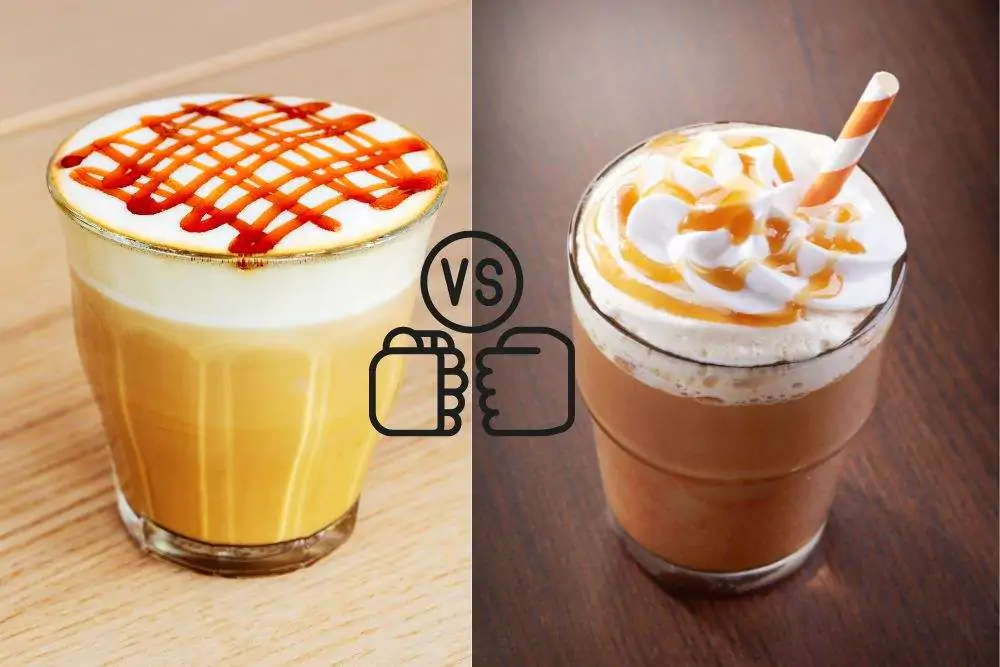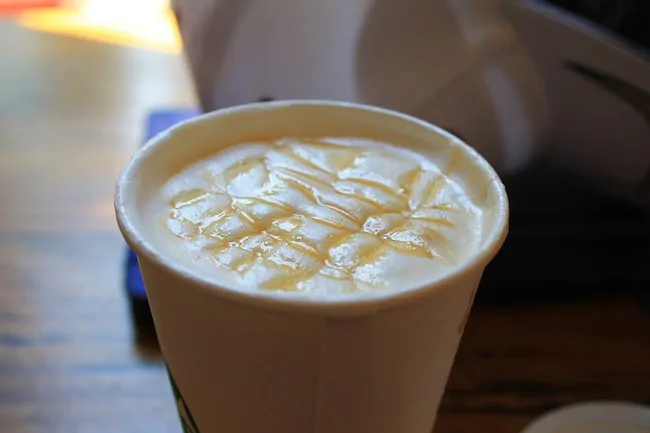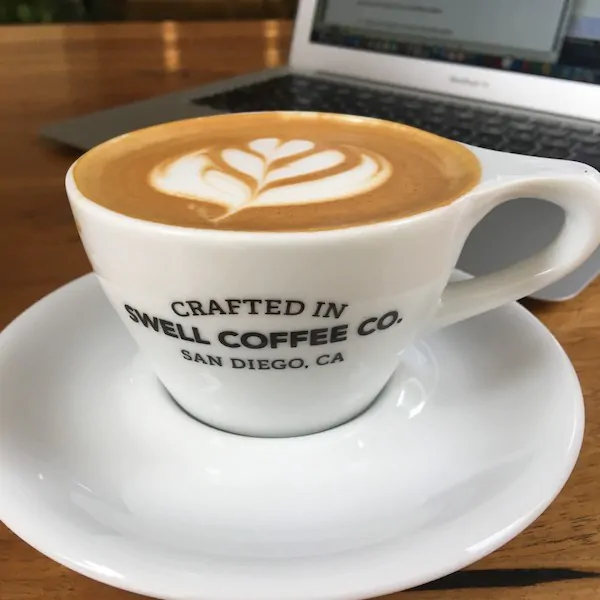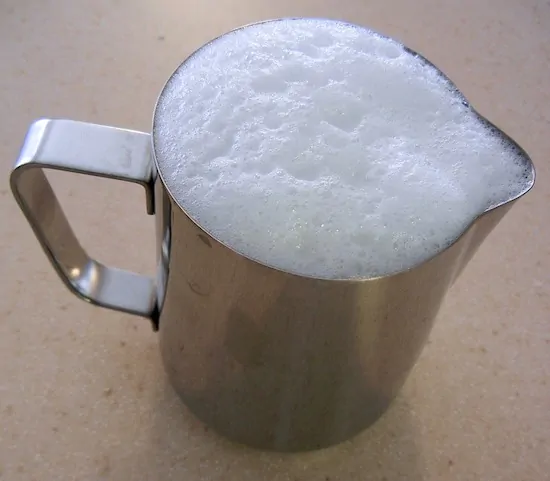In this article, we compare caramel macchiato vs. caramel latte so you can make the right choice in your local shop.

One of the great joys of making your own coffee at home is being able to re-create your favorite drinks from coffee shops. This method lets you save a significant amount of money, but it also allows you to customize your drinks to your liking.
However, when many people switch to making their own coffee, they don’t always know how to make their favorite drinks. Here, we’ll tackle two drinks that confuse many people–the caramel macchiato and the caramel latte.
- What's In A Caramel Macchiato?
- Customizing Your Caramel Macchiato
- Discovering The Caramel Latte
- In a Nutshell: the Difference Between the Caramel Macchiato and the Caramel Latte
- Tips For Making The Perfect Drink
- Syrup, Shot, And Milk Ratios
- Some Notes On Getting Your Steamed Milk Just Right
- The Secret To Getting Perfect Foam Peaks
- Experimentation Is the Fun Part
- Related Question
- Caramel Macchiato Vs Caramel Latte: The Final Word
- Coffee Type Guides
What’s In A Caramel Macchiato?
As one of the most popular drinks Starbucks sells, the caramel macchiato enjoys a consistently great reputation. And it’s spawned a generation of imitation products, too–walk through any grocery store and you’ll see caramel macchiato flavored creamers and even coffee pods.
Despite its popularity, the caramel macchiato is still widely misunderstood. Part of this is due to the name. Coffee aficionados were well aware of the macchiato long before the launch of the caramel macchiato.
And while the names are similar, these are very different drinks.
The macchiato is one of the cornerstones of Italian coffee culture. And it’s a simple drink: an espresso shot (or more than one) is poured in a small cup, with a dollop of foam from steamed milk served on top. The name macchiato means “marked,” and the espresso is marked by steamed milk.
This drink is usually unsweetened (unless you ask for it to be sweet), and some skilled baristas may even trace designs into the foam. This is a drink that’s great for those who like the dense, dry foam of a cappuccino, but who want a drink choice with less dairy or fewer calories. You might also be interested in learning about what a cloud macchiato is.

The caramel macchiato is a whole different animal. This drink, which has both more sweetener and more milk, was designed to appeal to the average person (and not just to espresso lovers). One of the most common misconceptions is that the drink is flavored with caramel syrup.
However, it’s actually sweetened with vanilla syrup. A caramel macchiato is made like an upside-down latte: steamed milk is poured into the cup after the vanilla syrup, and the shots and milk foam are poured on top.
From there, caramel drizzle is poured in a crosshatch pattern over the top. This flavor balances nicely with vanilla.
Customizing Your Caramel Macchiato
We mentioned that part of the fun of making your own coffee is experimenting with a drink to really make it your own. And the best part is that if you don’t like a variation you made, you won’t be out five to seven dollars. These are some of the variations you can create.
Different Kinds Of Milk
Most coffee shops use two percent milk as a standard, but you can customize your drink with several milk choices:
- Breve — Also known as half and half, this rich milk choice will transform your drink into a decadent delight.
- Whole Milk — Whole milk, much like breve, adds richness to your drink.
- Skim Milk — The caramel macchiato is a delicious drink on its own. If you’re looking to cut down on fat intake, it’s still delicious with skim milk.
- Non-dairy milk — Whether you’re concerned about animal welfare, have an allergy, or just feel like trying something new, non-dairy milk is a great choice. Soy milk (especially if it’s vanilla flavored) tastes great in a caramel macchiato, and it also creates the best foam.
- Almond milk and coconut milk — are also good choices, but they are somewhat difficult to foam.
If you’re new to steaming your own milk, it might take a little longer to get the hang of it with these milks.
Extra Drizzle
The caramel drizzle poured over a caramel macchiato is one of the best parts of the drink. It’s similar in consistency to the caramel dip for apples you commonly see at the store. If you want a little extra sweetness, try lining your cup with drizzle before pouring the milk, and then add the crosshatch on top like normal.
Different Syrup Flavors and Types
Experimenting with flavor can quickly become a fun adventure. And since you can purchase small bottles of coffee syrup inexpensively, you can easily amass a small collection. If you love caramel, you can try this drink with caramel syrup, or even a mixture of caramel and vanilla.
Hazelnut and French vanilla are both great choices. And if you’re trying to cut back on carbs, you can also make a caramel macchiato with sugar-free syrup.
Making It Upside Down
Since a caramel macchiato is essentially an upside-down latte, the upside-down version is made like a regular latte. If you like lots of extra caramel drizzle, try putting this in the bottom of the cup with the syrup, and then pull your shots directly into the cup and swirl them. This will help melt the caramel drizzle and distribute it more evenly through your drink.
Making It With Ristretto Shots
Not all espresso machines have this capability. But if yours does, it’s an option worth trying. For the uninitiated, a ristretto shot is one that pulls a little faster.
The result is an espresso shot with slightly less volume than normal. But volume isn’t the difference that matters–ristretto shots have a slightly sweet, almost nutty taste to them, and this is a flavor that goes especially well with the light, caramel-vanilla taste of a caramel macchiato.
Making It Iced
The caramel macchiato is also popular as an iced drink. For these drinks, add ice and syrup to your cup first. Then pour cold milk and add shots and caramel drizzle on top. This makes a sweet, refreshing drink perfect for summer.
Discovering The Caramel Latte

The caramel latte is another well-loved drink. And while some may confuse it with the caramel macchiato, it’s much simpler to make. This drink is sweetened with caramel syrup.
Once the syrup is added, you simply need to add your shots, pour steamed milk and milk foam on top. This helps create a pleasant coffee-caramel taste throughout the drink.
Much like with the caramel macchiato, you can try countless variations on this drink. Caramel is a flavor that agrees with dairy and non-dairy milk, although it goes especially well with the light, sweet flavor of coconut milk. And if you want a drink that’s a little sweeter, you can even add caramel drizzle or even whipped cream to the top.
For an especially decadent treat, try adding the whipped cream to the bottom of the cup–the shots and warm milk will blend it in so you can taste it with every sip. And while it changes the drink from being a caramel latte to a combination of flavors, adding some vanilla or hazelnut syrup can create some variety.
This drink can also be made iced. If you’re making a large drink, you may want to add an extra shot of espresso. Most coffee shops will do this. This is because the melting ice can create a watery taste, and the extra espresso keeps your drink from tasting watered down.
In a Nutshell: the Difference Between the Caramel Macchiato and the Caramel Latte
While we went into depth above, the following table might help you remember the main differences between these two drinks:
| Drink |
Milk |
Shots |
Flavor/Sweetener Syrup |
Extras |
| Caramel Macchiato | Your choice–most coffee shops use 2% as standard | Poured over milk | Vanilla | Caramel drizzle on top |
| Caramel Latte | Your choice–most coffee shops use 2% as standard | Poured before milk | Caramel | None |
Tips For Making The Perfect Drink
Now that you know what sets these two popular drinks apart, you’re ready to make your own. But as you probably already know, making good coffee is an art, and each component counts. Here are some tips to help you make a caramel latte, a caramel macchiato, or both.
Related Article: DIRTY CHAI LATTE VS CHAI LATTE
Steaming The Milk
For those newer to creating espresso drinks at home, steaming milk sometimes poses a learning curve. It’s well worth learning to do it, though–steaming milk creates foam, which gives many hot espresso drinks their distinctive, silky texture. To use the steam wand, start with a steaming pitcher of cold milk.
Put the tip of the steam wand right below the surface of the milk and turn it on. You should see some bubbles begin to form. Wait a few seconds until the sound turns quieter–it should sound like tearing small pieces of paper.
From there, plunge the steam wand closer to the bottom of the pitcher. Some higher-end wands will stop automatically once it reaches an appropriate temperature, but you can also watch the milk for signs that it’s done. If you’ve steamed correctly, the milk will appear to almost double in volume, and the large bubbles will break up into small, barely noticeable bubbles.
Once it’s steamed, you can also “groom” the milk by gently swirling it and tapping the pitcher on the countertop. This will help get rid of any remaining large bubbles in the foam.
It might take some practice with your machine to get the right consistency of steamed milk and the right amount of foam for you. Make sure you avoid over-steaming, though–this will overheat the milk and give it a burned taste.
Espresso

Making great espresso drinks starts with a good espresso machine and excellent quality beans. Before making a drink, make sure your machine is calibrated to pull shots properly.
You usually want shots to take between 25 and 30 seconds. If shots take too long to pull, they will taste bitter (and also watery, which makes for an interesting but unpleasant tasting experience).
Bean quality is one area where many people are tempted to cut corners. And if you drink a lot of coffee, it’s understandable–good coffee beans are expensive. It’s best to get Arabica beans, which most quality coffee roasters have.
If you’re new to making your own espresso, you might also be tempted to get pre-ground coffee. This choice might seem to make sense at first. After all, a grinder is an extra expense, and grinders can be somewhat loud.
But if you’re serious about great coffee, grinding your espresso coffee beans immediately before making a drink is key. Pre-ground coffee means that a greater surface area is exposed to air, and this has the potential to take away flavor.
You can certainly buy fancy grinders, but you also can purchase perfectly functional ones for less than $20. make sure that you grind your beans on the finest setting, as this will result in the ideal flavor profile for espresso.
One other thing that matters when you make espresso is the water you use. If possible, use cold, filtered water. Just as impurities in tap water can negatively affect taste, they also can impact the flavor of a finished espresso drink.
Syrup, Shot, And Milk Ratios
It’s difficult to come up with a perfect ratio of syrup, shots, and milk, since everyone will have slightly different tastes. But if you want a baseline recipe to follow, here’s one used by many coffee shops.
One thing many people have trouble measuring is syrup. This is because most coffee shops use syrup pumps, and one shop’s pump will usually yield a slightly different syrup volume than another shops. And since many small at-home coffee syrups are poured, it’s hard to gauge what volume to use.
Here. we’ve used a tablespoon measurement–one pump of syrup at most coffee shops is equivalent to half a tablespoon. Since many coffee shops err on the side of making a drink too sweet, you may want to scale back the syrup measurement if you prefer your drinks less sweet.
For a 12 Ounce Drink
- Slightly less than 12 ounces cold milk (how much you use depends on how much foam you want–if you want more foam to fill the cup, use less milk.
- One shot espresso
- 1.5 Tablespoons syrup
For a 16 Ounce Drink
- Slightly less than 16 ounces cold milk
- Two shots espresso
- 2 Tablespoons syrup
For a 24 Ounce Drink
- Slightly less than 24 ounces cold milk
- Two shots espresso
- 2.5 Tablespoons syrup
Some Notes On Getting Your Steamed Milk Just Right

Your treatment of milk will play a big role in your results when making a caramel macchiato or latte at home. There are some “best practices” to follow when steaming your milk. Let’s cover what you need to know to create “professional” steamed milk at home.
Full-fat milk tends to work best when steaming milk to create froth. However, it’s really up to you to decide if you prefer to use a low-fat option like skim milk. Just be warned that options other than whole milk may not produce the same thickness and density.
The coldness of your milk will also contribute to your results. Milk that is very cold tends to produce better, faster results. You can keep milk colder by storing it near the back of the refrigerator instead of near the door.
The big question on everyone’s mind when they first get into making macchiatos or lattes is how to froth milk. You actually have a few different options. Yes, you may need to buy a piece of simple equipment if you’re serious about making fancy coffee drinks at home.
Let’s start by talking about how to foam milk by hand. Simply pour your milk into a microwavable glass jar with a very tight, secure lid. Next, shake the milk for between 30 and 60 seconds to create foam.
You will then place the jar of newly foamed milk into the microwave. It will only take between 10 and 20 seconds to stabilize the foam. However, you can adjust the actual heating time based on your microwave’s settings.
You will have stable, rich foam when you pull your jar out of the microwave. The fun part comes next! Simply pour that foam into your mug to enjoy a coffee drink with steamed milk!
You can still make steamed milk by hand if you don’t have a microwave. Simply pour your “shaken” milk into a pan on the burner. It may take a few minutes to get the foam stabilized at the right temperature using this method.
Next, let’s talk about various methods and contraptions you can use to steam milk at home if you are interested in buying a piece of equipment. Keep in mind that you don’t have to make a huge investment to be able to steam milk at home. Plenty of very small, portable milk “frothers” are available.
Many people who are just making “quick” lattes or macchiatos in the morning like to use handheld steaming wands. Wands simply stir your milk in a rapid motion to create instant foam. In fact, you can create foam right in your own mug using this option if your goal is to get your drink rushed out as quickly as possible.
The last option is a stationary milk frother. This typically looks like a petite blender or bullet. You simply pour, press a button and let the machine do the work of creating perfectly frothed milk!
The Secret To Getting Perfect Foam Peaks

How do coffee shops create those perfect foam peaks? There’s one thing that baristas do that most of us overlook when making macchiatos and lattes at home! All you need to achieve perfect foam peaks is a flat wooden spatula.
The temptation when making a macchiato or latte is to simply dump all of the steamed milk into your cup at once. However, you’ll actually get the best results by separating the steamed milk from the foam that has just been created. It’s incredibly easy to this!
Place a flat wooden spatula over your cup of steamed milk as you’re pouring it into your coffee cup. This will separate the liquid milk from the foam peaks you’ve created. Keep pouring until the only thing left in the cup of steamed milk is foam!
You can then use that wooden spatula to scoop up the thick foam that remains. Next, simply place the beautiful dollops of foam over your coffee drink! You will have barista-approved foam that looks like it came from a professional coffee house!
Experimentation Is the Fun Part
The takeaway when comparing macchiatos and lattes is that both drinks use the same ingredients to create two very different experiences. Experimenting with both of these fairly simple drinks is a good way to perfect the art of frothing milk. Don’t forget that the “secret” to making either is to properly separate your steamed milk from your froth peaks!
Related Question
What Kind of Caramel Is Used When Making a Caramel Macchiato or Caramel Latte?
It’s fine to use caramel topping that you find at the store. You can sometimes find fancier caramel toppings that are intended for coffee drinks in the coffee aisle. Additionally, some people prefer to melt caramel candies or blocks to create homemade caramel drizzle!
Are Caramel Macchiatos Really Sweet?
Every coffee chain has its own version of the macchiato. You may have tasted a macchiato that seemed like it was loaded with sugar. However, that isn’t necessarily the default state of a macchiato.
Some people add extra sweeteners and flavors to create a more intense taste experience. Just keep in mind that adding extra sweeteners and flavors will impact calorie totals and bean intensity.
Is a Caramel Macchiato Just a Reverse Caramel Latte?
This is one way of putting it. The easiest way to remember how to make a macchiato is to simply follow the reverse order used for making a latte.
Do Most Restaurants and Coffee Shops Make Caramel Macchiatos?
Yes, most coffee shops will make caramel macchiatos. However, they aren’t as common as lattes.
Can You Use Caramel Sauce Instead of Syrup When Making a Macchiato or Latte?
Yes, some people prefer to use caramel sauce instead of syrup when making coffee drinks. Caramel sauce is much thicker than caramel syrup. You should keep in mind that you may need to warm caramel sauce before you can drizzle it in a neat pattern over the top of your foam.
Can I Make a Caramel Macchiato or Latte Without Caramel?
Yes, you can simply leave out the caramel when making your macchiato or caramel latte. This can be a good option if you’re diabetic or trying to cut sugar from your diet. You can also shop for sugar-free caramel topping if you’re concerned about sugar content or calories.
Caramel Macchiato Vs Caramel Latte: The Final Word
Making espresso drinks at home is more than just a cost saver. It can provide a centering morning ritual, and it also is a uniquely rewarding experience to be able to make cafe-quality drinks for yourself and your friends. And once you’re familiar with making established drink recipes, you’ll develop the expertise and intuition necessary to make your own unique drink combinations.
If you found this guide helpful, check our explanation for Macchiato Vs Cortado Coffee.

